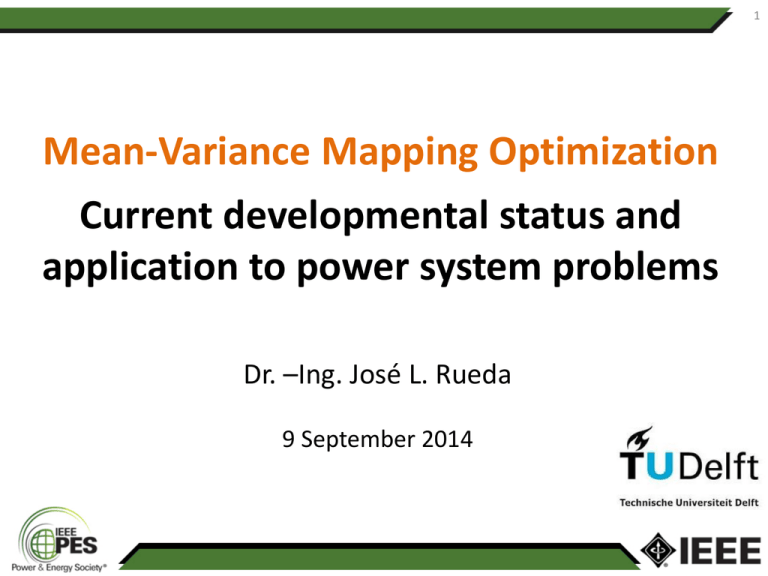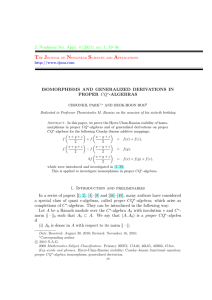Presentation
advertisement

1 Mean-Variance Mapping Optimization Current developmental status and application to power system problems Dr. –Ing. José L. Rueda 9 September 2014 Rationale behind MVMO 2 Start Initialize algorithm and optimization problem parameters Normalize optimization variables in vector x to range [0, 1] Introduced by I. Erlich (University DuisburgEssen, Germany ) in 2010 Internal search range of all variables restricted to [0, 1]. Solution archive: knowledge base for guiding the searching direction. Mapping function: Applied for mutating the offspring on the basis of the mean and variance of the n-best population attained so far. Fitness evaluation by using de-normalized variables Termination criteria satisfied? Yes No Fill/update solution archive (store n-best population Single parent assignment The first ranked solution xbest is chosen as parent Single offspring generation Selection: Select m (m<D) dimensions of xbest Mutation: Apply the mapping function for selected m dimensions Stop The hybrid variant: MVMO-SH Start Initialize algorithm parameters Generation and normalization of initial population i=0 k=1 No rand<gLS Yes Fitness evaluation Local search i=i+1 i=i+DFE Fill/Update individual archive Classification of good and bad solutions and parent selection No Bad particle? Single parent crossover based on local best Yes Offspring generation Multi-parent crossover based on a subset of good solutions Mutation through mapping of m selected dimensions based on local mean and variance k<NP Yes No No Termination criteria satisfied? k=k+1 Yes Stop 3 MVMO-SH: launching local search Local search performed according to rand g LS (1) where g LS : local search probability, e.g. g LS 1.5 /100 / D D: Problem dimension Different methods can be used: Classical: Interior-Point Method (IPM) Heuristic: Hill climbing, evolutionary strategies 4 Ranking Fitness x1 1st best Ranking F1Fitness Individual 2 x2 x1 ... x2 xD ... xD Optimisation 2nd best F1 F1Fitness 1st best Ranking x1 x2 ... xD Variables ... 2nd best Optimisation 1st best F1 F1 Variables Last best ...2nd best FA Optimization F2 Variables Last best... --- FA x1 x2 xD Individual 1 Individual NP MVMO-SH: solution archive s1 sx21 Last best --- F Mean A --Shape Mean d-Factor Shape d-factor s D xD dD s2 ds21 x --- d--1 1 x 2 sD xD sd12 s 2 dD sD --- ----- d1 x2 d1 d 2 dD 5 MVMO-SH: parent selection 6 All individuals ranked according to their particular best Bad solutions Good solutions Global Best Pi Random Good xbest RG best xGB x iparent =x ibest x i , si , d i Last First Good Bad Global Worst Pk xbest LG best best xkparent = xbest RG xGB xLG xk =xkparent , sk , dk Selection of m dimensions out of D for mutation via mapping function MVMO-SH: selection of dimensions for mutation 7 11 Method QP, quadratic progressive Method L, linear Method QD, quadratic degressive 10 a) The full range corresponds with the number of mutated variables, e.g. m =7 8 7 6 Range for mutation No. of variables mutated varied 9 5 4 3 2 Two different strategies are available: b) The number of mutated variables estimated randomly in the given range, e.g. m = irand(7) 1 0 0 200 400 600 800 1000 No. of iteration 8 MVMO-SH: selection of dimensions for mutation 8 Random-sequential selection mode child* x = Value inherited from x parent Generation n Selected pivot dimension xchild*= Generation n+1 Randomly selected dimension xchild*= Generation n+2 8 MVMO-SH: mutation based on mapping function 0 1 1 h xi (1 e xs1 ) (1 x i ) e (1 x )s2 xi hx (1 h1 h0 ) xi* h0 xi hx h( x xi* ) h0 h( x 0) 0 0 9 xi* 1 (2) (3) (4) h1 h( x 1) xi* and xi in the range 0 1 8 MVMO-SH: mapping function features 1 1 xi Parameter shape si1 = si2 xi 0.8 1.0 0.8 0.75 0.6 0.6 0.2 1 xi xi* 0.5 0.2 0 0 0 1 0.6 0.4 0.4 symmetrical mapping function si 1=si 2=10 0.2 1 symmetrical mapping function si 1 = si 2 = 10 0.8 0.6 xi* 0.5 1 xi asymmetrical mapping function si 1 = 20 si 2 = 10 0.8 0.5 0.25 0 0 Parameter: xmean si1 =si2= 10 0.4 0 5 10 15 50 0.4 10 asymmetrical mapping function si 1 = 10 si 2 = 20 0.2 0 0 0 0.2 0.4 0.6 0.8 xi* 1 0 0.2 0.4 0.6 0.8 xi* 1 MVMO-SH: assignment of shape and d-factors si1 si2 si ln(vi ) fs if si > 0 then Δd 1 Δd0 2 Δd0 rand 0.5 if si > di di di Δd else di di /Δd end if if rand < 0.5 then si1 si ; si2 di else si1 di ; si2 si end if end if Dd = 10 . (5) randomly varied Dd0 Dd0 dr is always oscillating around the shape sr and is set to 1 in the initialization stage Dd0 0.4 The d-factors remain dynamic with the mapping even the corresponding shape doesn’t change 11 MVMO-SH: assignment of shape and d-factors si1 si2 si ln(vi ) fs if si > 0 then 60 Δd 1 Δd0 2 Δd0 rand 0.5 if si > di di di Δd else si1 di ; si2 si end if end if 1.E+05 1.E+03 50 1.E+01 40 (5) 1.E-01 30 1.E-03 1.E-05 20 1.E-07 10 1.E-09 0 0 2000 4000 6000 Number of Iteration 8000 1.E-11 10000 CEC2013 function F1, single particle MVMO without local search, fs=1.0, Dd0=0.15 Fitness Shape Factors else di di /Δd end if if rand < 0.5 then si1 si ; si2 di shape factor from variance shape factor S1 shape factor S2 12 Application to power system problems 1. Optimal reactive power dispatch 2. Identification of power system dynamic equivalent 3. Online optimal control of reactive sources 13 Optimal Reactive Power Dispatch Minimize Losses Ploss subject to Operational constraints kN K g k Vi 2 V j2 2VV i j cosij p v, θ pg pd 0 (17) q v, θ qg qd 0 (18) v min v v max (19) q gmin q g q gmax (20) qcmin qc qcmax (21) t min t t max (22) s smax (23) (16) 14 Optimal Reactive Power Dispatch IEEE 118 bus system 77 dimensions (54 gen, 9 OLTCs, 14 compensators) 15 Optimal Reactive Power Dispatch 16 IEEE 118 bus system: Average convergence performance Optimal Reactive Power Dispatch 17 IEEE 118 bus system: Statistics of active power losses Ploss (MW) Algorithms MVMOS MVMO CLPSO SPSO UPSO FDRPSO DMSPSO-HS DE JADE-vPS Min 117.0802 117.0074 120.2117 121.8049 123.1174 119.1387 123.4717 118.7199 118.1047 Max 118.1662 125.1501 132.0461 125.4654 130.2011 123.5461 128.5504 121.1128 120.2177 Mean 117.4251 119.3353 122.2499 123.6784 125.6709 121.6536 125.0562 119.7737 118.9533 Std. 0.2285 1.9386 2.0533 0.9145 1.7663 1.0501 1.2033 0.6289 0.5321 Identification of dynamic equivalent 18 Ecuador-Colombia interconnected system Opt. problem 22 dimensions (reactances, gains, time constants) Ecuador (study area) Colombia (external area) 320 buses -- 64 generators 3.23 GW installed capacity 2.66 GW peak load 1729 buses -- 109 generators 11.08 GW installed capacity 8.78 GW peak load Identification of dynamic equivalent Dynamic equivalent for Colombia - Sixth order generator model - AVR model - Governor model Optimization problem 22 dimensions (Reactances, gains, time constants) 19 Identification of dynamic equivalent Optimization & Dynamic simulation 20 Identification of dynamic equivalent 21 Parameter identification problem statement Minimize p OF np w1 y1 y1ref np 1 0 2 System with component model to be identified subject to x j min x j x j max Parameters of the model w n yn yn ref dt 2 From PMU or simulations Identification of dynamic equivalent DE for Colombia: comparison of heuristic methods 22 Identification of dynamic equivalent DE for Colombia: comparison of dynamic responses Fault 1 Fault 2 Full system model With DE 23 Online optimal control of reactive sources WPP p+jq ● ● ● T2 T1 GRID PCC ● ● ● Xsh L1 CONTROLLER QPCC Qref - DQtotal PI Reference value Distribution factors, tap positions, reactor switching status Optimization MVMO every 15min On/off status and Loading of WG ( Pi & Qi ) DQ1* ● ● ● DQi* 24 Online optimal control of reactive sources 25 Other applications to power system problems 1. Active-reactive power dispatch 2. Short-term transmission planning 3. Location and tuning of damping controllers 4. Optimal transmission pricing 5. Optimal allocation and sizing of dynamic Var sources 26 Highlights 27 1. Winner of the competition on Expensive optimization at CEC-2014, Beijing, PR-China, 6-11 July 2014. 2. 4th out of 17 place in the competition on real-parameter single Objective optimization at CEC-2014, Beijing, PR-China, 6-11 July 2014. 3. 6th out of 21 place in the real-parameter single Objective optimization at CEC-2013, Cancun, Mexico 21-23 June 2013. 4. Used for benchmarking in 2014 Competition on OPF problems organized by the Working Group on Modern Heuristic Optimization (WGMHO) under the IEEE PES Power System Analysis, Computing, and Economics Committee (https://www.uni-due.de/ieee-wgmho/) 28 Thanks! Dr. José L. Rueda J.L.RuedaTorres@tudelft.nl http://www.uni-due.de/mvmo/ MVMO-SH: parent selection 29 All particles ranked according to their local best Good Bad Dynamic Good/Bad Particle Selection: è The ranking is re-calculated after any function evaluation è The border between Good/Bad particles is shifted downwards with the progress of iteration GP round Np g p* (2) NP: number of particles i: function evaluation counter i / imax (3) * * * g p* gp_ini gp_final gp_ini (4) g* =0.7 g* =0.2 p_ini p_final MVMO-SH: parent selection xparent =xbest xbest xbest RG GB LG k =2 rand shift (6) shift =0.5 1 2 (7) (5) 0 At the beginning min max Range of random search for At the end min max Alternatively: 2.5 rand 0.25 2 0.5 (8) 30







